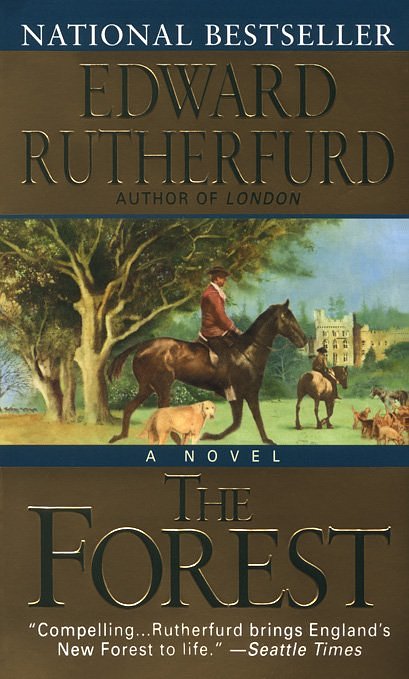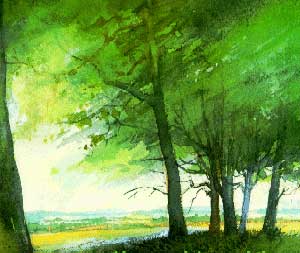|
The Place, The Book, A
Website

The New Forest is first
and foremost a place, it is a place that is time, and it is ancient. Edward Rutherfurds novel, The Forest, perfectly captures
the sense of time and place that is The New Forest . The germ of the idea for a website on The New Forest came in two parts,
first of all the book, and second, a page on one of our other websites,
The Prospect Before Us, where one of the pages is dedicated to four of Englands forests, The New Forest
being one of them. This site will be structured somewhat like Edward Rutherfurds book, with references to his fictional families,
but in the main, dealing with the same historical time frame that Edward Rutherfurd uses and some of the page titles will
be the same as the books part titles, eg. The Rufus Stone. The ordering will be slightly different. Along with everything
else, there are some maps to guide you, and brief synopsise of what we consider to be some key points in The Forests
history, along with lots of links to the apropriate websites, out there on the net.
Come with us, now, and walk through time, and walk through this place called...... The New Forest.
Forest Historical Facts
Within the New Forest there are no large earthworks, Roman Villas, or
medieval castles.
The Stone Age
The
large areas of heather moorland in the New Forest were originally dense woods. Stone Age settlers cut down many trees for
building and cleared the ground for agriculture.
The Bronze and Iron Ages
The change
from woodland to heathland accelerated with the bronze age appearing around 100 BC. Bronze age round barrows are plentiful.
The Iron Age followed. The field systems with banks and ditches are pre-Roman.
The Romans
The Romans started a thriving pottery industry. There are
many sites around the Forest each with a distinctive circular earth kiln. New Forest pottery has been found at most Roman
sites in southern Britain.
Angles,
Saxons & Jutes
After the Romans left the Saxons & Jutes from Northern Europe invaded Britain although
little has survived in evidence their language lives on in most of the local place names.
King William
In Saxon times the kings used the New Forest
for hunting. When William, Duke of Normandy, invaded England in 1066 and was crowned William I, the Nova Foresta came into
being and was mentioned in the Domesday Book in 1086. The New Forest was taken into Crown ownership and imposed laws to protect
the the forest and deer for Royal hunting.
The Rufus
Stone supposedly marks the spot when in August 1100 William II (Rufus) was killed by Walter Tyrell in
a hunting accident in the Forest. As has already been noted by Edward Rutherfurd, in The Preface, this not true, Rufus
was killed at Througham, a few miles south of where the stone is. The stone was erected by Earl De La Warr in 1745.
At the start of the nineteenth century the stone had become damaged and was covered in iron in 1841 to protect it from further
damage.
The inscription on the Rufus Stone reads: "Here stood the oak tree on which an arrow shot by Sir Walter
Tyrrell at a stag glanced and struck King William II surnamed Rufus on the breast of which storke he instantly died on the
second day of August anno 1100. King William thus slain was laid on a cart belonging to one Purkess and drawn from hence to
Winchester, and buried in the Cathedral Church of that City"
17th Century
Bucklers Hard
village was built on the Beaulieu river to bring timber down to the Solent to be used in the production of many Royal Navy
war ships but the scale of the needs of the Royal Navy caused the siezing of thousands of acres of forest purely for timber
growing.
The Act Of 1877
After many Acts of
Parliaments throughout the following years in 1877 the New Forest Act, sometimes referred to as the 'Charter of the Forest'
or the 'Commoners Charter' was passed.
The Act protected the old woodlands allowing only the commoners to take fuel
wood right provided the ornamental trees were not cut down.
The Court of Verderers was empowered to employ staff and
collect a marking fee for each head of commoners stock that roamed the Forest, their role was also to look after the New Forest
commoners and made bylaws.
1914-45
Heavy felling of trees for the war were replaced by
conifers. Then in 1928 the Forestry Commission assumed responsibility for bridges and drains and the clearance of conifers.
This was again halted due to the arrival of the 1939-45 war. During the Second World War 10 airfields were built in and around
the New Forest including Bealieu, Holmsley and Stony Cross.
1949 New Forest Act
Membership
of the Court of Verderers was increased to 10. By 1964 the main A31 was fenced. The rest of the area was still wide open with
no fencing along any of the other forest roads allowing the livestock to wander freely outside the forest limits.
1964 New Forest Act
The Forest increased in size, taking Hale Purlieu in the north, Cadnam, Furzley,
Half Moon, Penn, Plaitford and West Wellow commons in the north-east and the common lands of Hythe, Ibsley, Rockford and parts
of Kingston Great in the west.
1970 New Forest Act
The main provision
was to correct the oversight from the 1968 Countryside Act which gave the Commission wide powers to make provision for recreational
use on land they managed.
1971
The New Forest was declared a Site of Special Scientific
Interest by the Government. In November 1971 the forest became a car free area and a large number of car parks were made coupled
with a series of camp sites.
1992
The Government agrees special status equivalent to
a National Park.

|
 |
|


|
|
the
recitation you heard
on the opening page is
explaining to us the function of trees
and why we as humans need them
It first appeared and still is there
along with other music from
the Sway With Me album
by Judy Dunlop and
Ashley Hutchings | | |
|
|
The body that co-ordinates the management
of the New Forest Heritage Area
The Official Website
excerpts from
Landscape and Memory
by Simon Schama
published by
Vintage Canada
The Forest Website is
© 2002/2003/2004
the albionchronicles
All Rights Reserved
| | |

|
 |
 |
 |
|
|
 |
 |
 |
|
|
|

